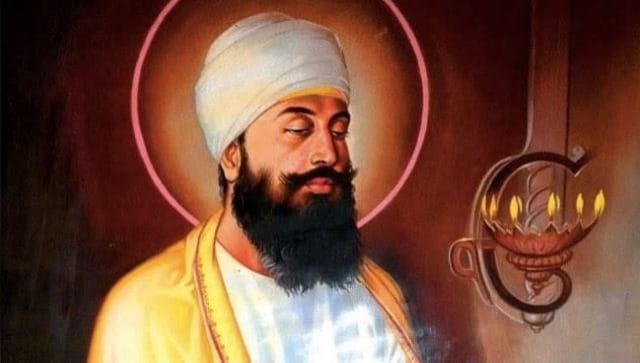The two-day mega event organised by the Centre to commemorate Guru Tegh Bahadur on his 401st birth anniversary will culminate with Prime Minister Narendra Modi’s address from the Red Fort today.
The speech is expected to be delivered at 9.30 pm after ‘shabad kirtan’ by 400 Sikh musicians. Modi will also release a coin and postage stamp in honour of the ninth Sikh guru.
Prime Minister Narendra Modi will address the nation from Red Fort today to mark the 401st birth anniversary of Guru Tegh Bahadur.
The Bharatiya Janata Party’s grand celebrations are an attempt to win over the Sikh vote bank. It’s something the party is going after since the split with the Shiromani Akali Dal in Punjab over the Centre’s controversial farm laws. The legislation was famously repealed on Guru Nanak Jayanti last November.
The BJP lost the Punjab Assembly elections but is already in preparation for the 2024 general elections. It’s leaving no stone unturned for the Guru Tegh Bahadur event.
The legend of Guru Tegh Bahadur
Born in Amritsar on 21 April 1621, Tegh Bahadur was the youngest son of Guru Hargobind, the sixth guru, who introduced the concept of warrior saints.
Growing up, Tegh Bahadur learnt Gurmukhi, Hindi, Sanskrit, and religious philosophy and was also trained in swordsmanship and archery.
He is considered a scholar and a poet who made valuable contributions to the Sri Guru Granth Sahib, the holy book of Sikhism.
The road to becoming the guru
After the fourth Sikh guru, Guru Ram Das, the guruship became hereditary. After the death of Tegh Bahadur’s elder brother Gurditta, his 14-year-old son Har Rai was made the guru. He was succeeded by his son Guru Har Krishan, who passed away in Delhi in 1664 before he could reach the age of eight, reports The Indian Express.
When Har Krishan, who died because of smallpox, was asked who would succeed him, all he said was Baba Bakala.
By then Guru Tegh Bahadur has moved from Amritsar to Bakala, where he spent a lot of time meditating. Since Har Krishan had not spelt out who would be the next Sikh leader, many laid claims to the role.
The lore of 500 gold coins
Legend has it that a wealthy trader, Baba Makhan Shah Labana, had prayed for his life when his ship was caught in a storm and had promised to gift 500 gold coins to the Sikh guru if he survived. But when he reached Delhi, he learnt that Har Krishan had passed away and many claimed to be the next guru.
Labana went from one claimant to the next, hoping to find the guru who would have heard his silent prayer. He would offer them two gold coins which they would accept, leaving the trader disappointed.
Then Labana heard of Tegh Bahadur who was medidating in Bakala and rushed to him. He offered the guru two gold coins which he accepted but went on to tell the trader that it fell short of the promise he had made.
Labana was elated and ran to the rooftop and shouted “Guru ladho re, Guru ladho re (I have found the guru)”.
Tegh Bahadur went on to become the ninth Sikh guru.
The fight for religious freedom
During his time as the guru, Tegh Bahadur‘s fight for religious rights was relentless. One of his key teachings was that one should willingly follow a particular faith and not be forced into it.
It was the 17th Century and Mughal emperor Aurangzeb was the ruler then. He imposed the Sharia law across the empire and is believed to have forcibly converted many to Islam.
Several Kashmiri Pandits fled these conversions and sought refuge with Guru Tegh Bahadur, according to Sikh legend. The guru decided to visit the Mughal emperor to dissuade him from imposing Islam.

Prime Minister Narendra Modi visited Gurudwara Rakab Ganj Sahib in Delhi in 2020 on the Sikh guru’s death anniversary. Image Courtesy: Narendra Modi/Twitter
The martyrdom
There are different versions of what happened when the two came face to face. Some say the king asked him to perform a miracle which he refused; others believe that Aurangzeb asked the Hindus for someone ready to sacrifice himself for their religion and Guru Tegh Bahadur volunteered himself, reports ThePrint.
In a paper titled ‘Who killed Guru Tegh Bahadur?’, historian Sardar Kapur Singh wrote that Aurangzeb ordered the public execution of the guru on 11 November 1675 after the guru declined to embrace Islam, according to The Indian Express. He was tortured to death and beheaded at Chandni Chowk.
The guru’s body was cremated at Rakab Ganj Sahib in New Delhi. Today, it’s a gurudwara that stands between a church and a masjid, a fitting resting place for the leader who fought for tolerance and religious freedom.
“No one else sacrificed himself for the people of another religion,” a member of the Delhi Sikh Gurdwara Management Committee (DSGMC), which is headquartered at Rakab Ganj Sahib, told ThePrint.
At the Red Fort event today, Prime Minister Modi is expected to talk about interfaith peace. It’s a lesson India needs as the country has seen a rise in communal clashes over the last 10 days.(First Post)

Readers like you, make ESHADOOT work possible. We need your support to deliver quality and positive news about India and Indian diaspora - and to keep it open for everyone. Your support is essential to continue our efforts. Every contribution, however big or small, is so valuable for our future.












